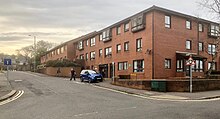Greenock Royal Infirmary
History
The facility had its origins in a dispensary for the sick poor which was established in 1801 in the town centre near the harbour, initially in Manse Lane, then nearby in Cathcart Street. This provided medicines, and a surgeon made daily visits to the poor when they were sick at home. In 1806 a contagious fever spread from the crew of a Russian prize ship in the harbour, causing many deaths, and one of the surgeons proposed a new hospital or fever-house, "where the poor would be removed from their own uncomfortable dwellings, not only for their own sakes, but for the purpose of checking infection."
In 1807, funds were raised to build a Hospital or Infirmary, and a site obtained on the south edge of the town, up on the east side of Inverkip Street between the Anti-Burgher Secession Church of 1803 (called the Canister Kirk for its shape) and the 1789 cemetery. The building on Inverkip Street was designed by the local harbour engineer, John Aird, the foundation stone was laid in 1808, and the first patient was admitted in June 1809. The building was erected at an expense of £1815, on a site of land given by Sir John Shaw Stewart.
The infirmary was extended with wings added in 1830 after another fever epidemic, and an 1847 extension incorporating the site and parts of the Canister Kirk continued the hospital round into East Shaw Street. A new Hospital and Infirmary building designed by Salmon and Son was added on the adjacent site at 2 Duncan Street in 1869. It was renamed the Greenock Royal Infirmary in 1922 and joined the National Health Service in 1948.

After services transferred to the Inverclyde Royal Hospital, the Greenock Royal Infirmary closed in 1979 and was subsequently demolished. The site was then used for a Sheltered housing complex providing 34 flats (for seniors) with associated facilities, built in 1988, which is named John Galt House in commemoration of the novelist and entrepreneur John Galt who was buried in the adjacent Inverkip Street Cemetery in 1839.
Notable nursing staff
The first nurses that trained on the Nightingale system started working in Greenock Royal Infirmary in 1968. This included Miss Beatty who was appointed as Lady Superintendent of Nursing.
The Edinburgh Nurses Training Society sent female nurses of ‘high moral character’ to be probationary nurses and receive a one year training at Greenock Royal Infirmary. In 1870, Miss Beatty left and was replaced by Miss Johnstone who had worked at Glasgow Royal Infirmary. By 1871 there were 21 nurses. Several nurses at this time were ill with fever and smallpox, of which two died.
Miss Johnstone died in 1884 after 15 years’ service and was replaced by Miss Fletcher as Lady Superintendent. Miss Tod took over from Miss Fletcher in 1887 and worked as the matron for 27 years, retiring in 1914. Miss AM Filley took over this role and also worked as the Matron for 27 years. Miss G Manners was Matron from 1942-1947, leaving to take on the role of Matron at Glasgow Royal Infirmary. She was succeeded by Miss MB Crichton who retired after 17 years service in 1963.
With the introduction of the State Registration of Nurses in 1920 the infirmary’s training school adopted the three year training programme. In 1964 a two year course for State Enrolled Nurses was established.
Miss E Beaton received the RRC for her work in the Third Scottish General Hospital in 1916.
References
- ^ "Records of Greenock Royal Infirmary, Greenock, Scotland". Archives Hub. Retrieved 2 February 2020.
- ^ "History of the Town of Greenock – originally published in 1829". Inverclyde Council. 12 November 2019. pp. 10, 15. Retrieved 6 February 2020. pdf
- ^ R.M. Smith (12 November 2019). "The History of Greenock – Originally published in 1921". Inverclyde Council. pp. 117–118, 154. Archived from the original on 3 June 2021. Retrieved 6 February 2020. pdf
- ^ "Inverclyde: Greenock Royal Infirmary". Historic Hospitals. Retrieved 2 February 2020.
- ^ "A Topographical Dictionary of Scotland. Originally published by S Lewis, London, 1846". British History Online.
- ^ Wood, John (1835). "OS large scale town plan of Greenock". Maps of Scotland. Retrieved 6 February 2020.
- ^ "Ordnance Survey large scale Scottish town plans: Greenock 1:500". Maps of Scotland. 1857. Retrieved 6 February 2020.
- ^ "Official start made to £7m. hospital". The Herald. 1 September 1970. p. 3. Archived from the original on 7 March 2017. Retrieved 6 November 2016.
- ^ "Greenock, 2 Duncan Street, Greenock Royal Infirmary". Canmore. Retrieved 9 February 2020.
- ^ Carruthers, Gerard (2012). "Remembering John Galt". In Hewitt, Regina (ed.). John Galt: Observations and Conjectures on Literature, History, and Society. Lewisburg: Bucknell University Press. p. 33. ISBN 978-1-61148-434-2.
- ^ "John Galt House - 2 Duncan Street, Greenock, Renfrewshire, PA15 1PA - Sheltered housing, retirement housing, supported housing for older people". Housingcare.Org. Elderly Accommodation Counsel. Retrieved 7 February 2020.
- ^ Ferrier, John (1968). The Greenock Royal Infirmary 1806-1968. Greenock and District Hospitals Board of Management.
- ^ Ferrier, John (1968). The Greenock Royal Infirmary 1806-1968. Greenock and District Hospitals Board of Management.
- ^ "Retirement of Miss A. M. Filley". The Nursing Record. 89 (2078): 156. 1941.
- ^ "Retirements". Nursing Times. 59: 1072. 1963.
- ^ Ferrier, John (1968). The Greenock Royal Infirmary 1806-1968. Greenock and District Hospitals Board of Management.
- ^ "Royal Red Cross—Notes on Some of the Recipients". Nursing Times. 12 (581): 739.